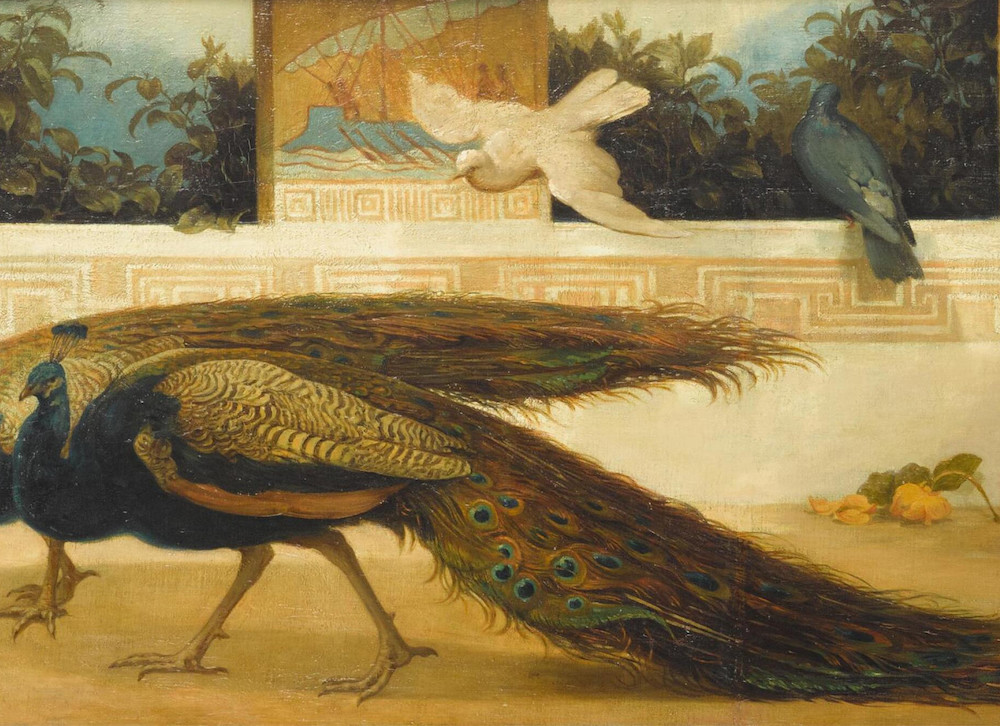
Peacocks by Alfred Sacheverel[l] Coke (1846-1924). Signed and dated lower left, 1874. Further titled, signed and inscribed with the artist's address Peacocks / A.S. Coke / 5 The Mall / Park Road / Haverstock Hill / London on the artist's label attached to the reverse. Oil on canvas. Unframed: 68.6 x 201.9cm. (27 x 79.5in.); framed: 76 x 210cm.(30 by 82.5in.). Courtesy of Sotheby's. [Click on the image to enlarge it.]

Closer view of the girl feeding the peacocks.
As Sotheby's catalogue note points out, it is very unusual for large works by Coke to become available on the art market. This one is very much of its time, and belongs to the early phases of the Aesthetic Movement. It is obviously similar in style to Frederic Leighton's paintings of classical subjects, and in subject, though not in composition, to Leighton's earlier Girl Feeding Peacocks (1862, another work in a private collection). Naturally, it attracted a great deal of attention and a high price at auction. From its size and narrow shape, the catalogue note deduces that "it might have been part of a decorative scheme for a fashionable interior," which does seem likely. Coke later exhibited painted panels at the Arts and Crafts Exhibition Society's third exhibition in 1888, when, incidentally, he is listed as "Coke, Sir A. Sacheverell" (261). Other artists besides Leighton painted peacocks, often, like Walter Crane, with whom Coke sometimes collaborated, for decorative purposes, and another of Coke's contemporaries, Albert Moore, made the birds the subject of a decorative frieze for a private house (information from the Sothey's catalogue note).

Closer view of the peacock to the right, and the details on the far right.
Coke was clearly very much involved in the artistic circles of his age, witness his participation in the Painters' Masque and Costume Ball of May 1885, in which he presented an "admirable opening tableau" and then represented Dante in Crane's "fine triptych illustrating the arts of Florence, Rome, and Venice" — as reported in the Illustrated London News at the end of that month.
Whatever the influences here, this is a stunning composition, both elegant and natural. Neither the girl in her loose, swirling costume, nor the birds with their long unfurled tails, lose anything by being stooped in this elongated canvas, and the colours are perfectly balanced, even to the point that the shade of the costume's fabric is picked out again in the frescos in the background and the damaged flower on the far right, which has evidently fallen from greenery intruding (like the dove) from the outside. The sense of inner/outer spaces is also beautifully conveyed by this, and by the white dove flying in for the feast, and the more common grey-blue pigeon perched on the low wall, facing outwards. The Greek key pattern along the wall, and the ships in the frescoes, add to the classical ambience of the work.
Works of this period featuring peacocks (a selection)
- A Peacock, by Edward Burne-Jones (1886-89)
- The Peacock's Complaint by Walter Crane
- The Peacocks in a Garden (tile design), by Walter Jenks Morgan
- The Peacock, by Harrison Weir
Bibliography
Arts & Crafts Exhibition Society: catalogue of the third exhibition, the New Gallery, 121 Regent St. 1890. London: Arts and Crafts Exhibition Society, 1890. Internet Archive, from the V&A's collections. Web. 8 June 2025.
Catalogue Note. Sotheby's. Web. 8 June 2025. https://www.sothebys.com/en/buy/auction/2023/european-british-paintings/peacocks
"The Painters' Masque and Costume Ball." Illustrated London News Vol. LXXXVI. 30 May 1885: 556. Internet Archive. Web. 8 June 2025.
Created 8 June 2025